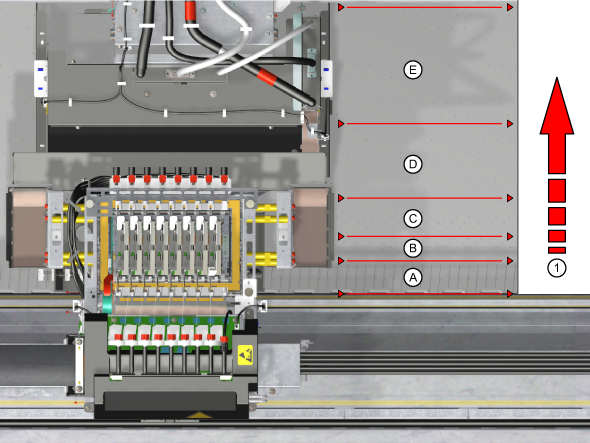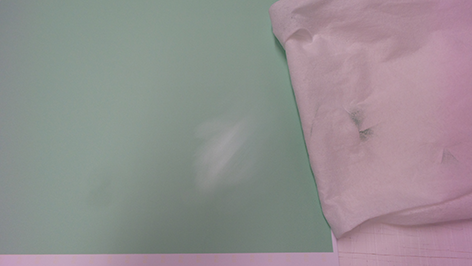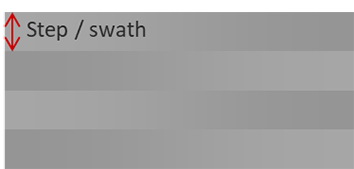

You can change the media settings of a media profile in the RIP.
Only when you create a new media profile or edit an existing media profile you can tune the media settings. It is advised to use the Colorado 1650 media profiles and not change the media settings. Only advanced users or application specialists should edit media profiles and have to tune the media settings.
Changing the media settings can cause damage to your printer which may void your machine warranty service.
Changing the media settings can result in poor print quality.
This manual provides you with basic information in order to create and change media profiles. Profiling is an expert task which requires additional information and tools not covered by this manual. Contact your local support organization when you want to create or change media profiles.
The location of the media settings differs, depending on the RIP you are using. For more information, see Manage media profiles in ONYX, Manage media profiles in Caldera.
|
[Media setting ] |
Description |
|---|---|
|
[Automatic advance correction] |
Prints yellow or black markers on the media that the printer uses as guidance to optimize the media step accuracy. Select [Normal] to print the yellow markers or [Enhanced] to print the black markers. Select [None] when you do not want to print markers. Use [Normal] as a default. Typically for smooth, white, opaque, non-reflective media types, or when your applications demand markers that are not visible with the naked eye. Use [Enhanced] for textured and reflective media. The printer can detect black markers more easily. Take note that these markers are visible with the naked eye, unlike the yellow markers. Black markers may have to be cut out from the printed output, depending on your applications. When the printer cannot read the markers, due to the media type used, a message appears on the operator panel. Select [None] when both yellow and black markers cannot be read. See Solve specific quality problems. The use of markers has influence on the width of the print: [None] adds no width but uses the 5.3 mm (0.21 inch) default margin, [Normal] 8.9 mm (0.35 inch) margin, [Enhanced] 17.5 mm (0.69 inch) margin.
|
|
[Vacuum power] |
Controls the suction of the media on the platen. Per media category default values are used for each of the five zones available. Only change the vacuum power when you encounter problems:
Location of the zones A, B, C, D, E, with (1) media transport direction: 
|
|
1 Swath boundary. Two adjoining swaths/passes of the printhead must be positioned without overlap (dark lines), or gap (white lines ). 
|
|
|
[Winding tension] |
Controls winding. For printing without winding or for winding without tension bar select [No tension bar] . For certain media types it is necessary to wind the media with a tension bar in order to let it run smoothly. Select [Tension bar] for media that is weak and buckle-sensitive but not too stiff. Select [Locked tension bar] for media that is very stiff . Depending on what is selected here, the operator panel will display a request for taping media, locking, or placing a tension bar. After you have changed the setting, make sure to reload the media roll in the media drawer. Only then the change will take effect. |
|
[Auto media advance] |
Prevents pinch roller marks that can occur on sensitive media while it sits idle in the loaded position or while it lies on the printer platen for more than two minutes. When you create a new media profile, [Auto media advance] is disabled by default. When enabled, this setting advances the media past the pressure point at the start of a print job or at the request of a manual cut. Depending on the media position, the setting can spool forward a longer media length.
|
|
[Carriage elevation ] |
Controls the height of the carriage. When [Automatic] is selected the optimal carriage height is automatically determined based on the [Media thickness ] set in the media profile. It is advised to select [Automatic] as this will result in the best print quality. Only select [Highest] when you are experimenting with new media that can touch the carriage. |
|
[Manual loading] |
Use this setting when you print on weak or curled media. Mostly used with a leading strip of rigid media. Width detection will be done just before printing at the position of the printhead. You can open the top cover and you can place the media manually in position. |
|
[Suitable for printer cutter ] |
Controls the use of the printer cutter. Disable the use of the automatic cutter when it is not suitable for the media type, for example with textile, canvas or heavy banners. When disabled the printer will request the operator to cut the media manually. After you have changed the setting, make sure to reload the media roll in the media drawer. Only then the change will take effect. |
|
[Outer core diameter ] |
Fill in the outer core diameter of the media roll in millimeters. With this information and the data collected while printing jobs, the printer will calculate the remaining media length. If the [Remaining length] is displayed as [Unknown] on the operator panel, continue printing until the remaining media length can be calculated. After you have changed the setting, make sure to reload the media roll in the media drawer. Only then the change will take effect. |
|
[Media thickness ] |
Fill in the thickness of the media before the media is loaded for the first time This value represents the total thickness of the media, e.g. for self-adhesive vinyl, PVC including the liner. The media thickness determines the printhead carriage height and must be set correctly in order to perform printhead carriage calibration.
|
|
[Moist sensitivity] |
Prevents to print on media that might have been affected by humidity or moisture. When you create a new media profile, [Moist sensitivity] is disabled by default: the value is set to 0. When enabled, the printer spools the media forward at the start of a print job or at the request of a manual cut after the defined inactivity time limit is reached: where value[1] is the longest time (1800 sec.), [2] (250 sec.), and [3] the shortest time (120 sec.). By spooling the media forward, the part of the media that is on the platen or that sits idle in the loaded position is not used to print on. It is advised to use the moist sensitivity setting when you use paper-based media that is sensitive to and exposed to temperature and humidity variation. This way you prevent printing on waved and wrinkled media and the print quality is not compromised. Incorrect moist sensitivity can cause waved and wrinkled media. This can lead to a carriage crash and can damage the machine, which may void your machine warranty service.
|
|
[ Advanced media step calibration] |
With this setting you can enable or disable an additional calibration. SAV media is more sensitive to a certain OD banding. With this calibration the paperstep is optimized for this OD banding. For SAV media this setting is automatically enabled. This setting can be disabled to reduce media calibration time and media waste. This additional calibration is intended for SAV media and should be enabled to get the optimal performance. In exceptional cases for media with OD banding enabling this setting might reduce the OD banding. |
|
Media settings |
Description |
|---|---|
|
[Printer platen temperature] |
Controls the temperature of the platen. Generally there is no need to change this settings. Therefore recommended to keep this setting as defined in the media profile, and only adjust after consulting with an application specialist. |
|
[Precure power] |
Controls the curing intensity of the LED for the first part of the curing zone. Default value is 0. Tune by decreasing or increasing the setting and minimize gloss banding, especially in dark areas. When you turn the [Precure power ] completely off ink adhesion can improve, but this can result in gloss banding. The LED is off when the value is set to -5. Tune with small steps of 1 or 2 at a time. Changing the curing settings can result in insufficient curing of the UV-ink layer. When you have changed the settings, wear Colorado 1650 approved gloves the first time you handle the printed output to prevent any possible contact with uncured ink. Changing the curing settings can result in insufficient curing of the UV-ink layer. Especially in combination with the [Moist protection] setting there is a risk the printer can get polluted. When the machine is polluted make sure you clean it or call your local service representative. |
|
[Throughcure/Postcure power] |
Controls the curing intensity of the LED for the subsequent part of the curing zone. Default value is 0. Increase to get rid of smudges (due to rubbing) or not fully cured ink. Decrease to minimize the appearance of a white haze on dark areas. Decrease to limit heating of the media. The LED cannot be turned off. Changing the curing settings can result in insufficient curing of the UV-ink layer. When you have changed the settings, wear Colorado 1650 approved gloves the first time you handle the printed output to prevent any possible contact with uncured ink. Changing the curing settings can result in insufficient curing of the UV-ink layer. Especially in combination with the [Moist protection] setting there is a risk the printer can get polluted. When the machine is polluted make sure you clean it or call your local service representative.  Smudging
Smudging |
|
[Pincure power] |
Controls the curing intensity of the LED for matte print modes. Default value is 0. Increase or decrease for minor adjustment of the gloss value, for respectively lower or higher gloss value. Decrease to lower the heat load on sensitive media. Decrease to diminish eventual visibility of print surface suction holes in case of very thin media. The LED cannot be turned off. Changing the curing settings can result in insufficient curing of the UV-ink layer. When you have changed the settings, wear Colorado 1650 approved gloves the first time you handle the printed output to prevent any possible contact with uncured ink. Changing the curing settings can result in insufficient curing of the UV-ink layer. Especially in combination with the [Moist protection] setting there is a risk the printer can get polluted. When the machine is polluted make sure you clean it or call your local service representative. |
|
[Advance correction (Caldera) / Step correction (ONYX)] |
Controls the average step size for the selected media and print mode. Only change this setting when media calibration, [Automatic advance correction] , and decreasing the vacuum settings do not help enough in improving the print quality. Decrease for smaller steps, in case of constant light lines (at the swath boundary). Increase for larger steps, in case of constant dark lines. When both light and dark lines are present, you cannot correct it via this setting.
|
|
[Print strategy] |
Controls the print strategy used for layering the ink. By using the right print strategy, the ink is positioned in such a way you optimize the print quality and especially reduce artefacts at swath boundaries. The [Print strategy] setting can be selected in the print modes shown in the illustration below "Print strategy selection".. For all the other print modes [Print strategy 1] is the default and cannot be changed. Only for specific media or when you want to optimize print quality, especially reduce artefacts at swath boundary, you should select a different value. Always evaluate the print quality after you have changed the value. For more information on [Print strategy] selection see the paragraph below.
|
|
[Optimized color profiling] |
The [Optimized color profiling] level is set as part of the color profiling sequence. When the level is set to 1, no color corrections are made. In case of wrinkles, increase the [Optimized color profiling] in order to reduce the ink limit in an optimized way. This will reduce the risk of wrinkles. |
|
[Flood Fill (Gloss)] |
Only for FLXfinish+. When this setting is checked and there is no gloss layer, the print is fully Gloss. When this setting is not checked and there is no gloss layer, the print is fully Matte. |

|
Strategy type b is more robust than type a (same print mode) for: Swath boundary lines or Gradient banding (OD/gloss variation within the swath). |


|
|
Risk for strategy b: Zebra banding (varies left-right and from swath to swath). This cannot occur for strategies of type a. |

|
|
Type a-hd are similar to type a, but allow for higher OD and have a higher risk image quality problems. |
Use the tables below to diagnose possible issues related to media and print modes. Start at the left column of the table and find your situation. Read the table from left to right find the problem and the resolution or action to take.
|
Media type |
Strategy (ONYX / Caldera) |
Result / action |
Strategy (ONYX / Caldera) |
Result / action |
|---|---|---|---|---|
|
Structured |
High density / Strategy 3 |
No action |
||
|
Smooth |
Default / Strategy 1 |
Print quality OK |
||
|
Lines at swath boundary or gradient banding |
Robust Quality / Strategy 2 |
Print quality OK |
||
|
Print quality not Ok, select a slower print mode |
|
Mode |
Strategy (ONYX / Caldera) |
Result / action |
Strategy (ONYX / Caldera) |
Result / action |
|---|---|---|---|---|
|
Production |
Default / Strategy 1 |
Paper step markers Off (AAC) Less robust for media step variations * Speed = 57 m2/h (187 ft2/h) |
||
|
Improved Media Step / Strategy 2 |
Paper step markers On (AAC) More robust for media step variations * More robust for gradient banding Speed = 53 m2/h (173.9 ft2/h) |
|||
|
High Quality mode Superior mode Specialty mode |
Default / Strategy 1 |
Media with less ink spread or Banding visible |
Robust 1 / Strategy 2 |
|
|
OD lines at swath boundary or gradient banding |
Robust 2 / Strategy 3 |
Print quality OK |
||
|
Print quality not Ok, select a slower print mode |
* Media step can be visible as dark or light lines at swath boundary.